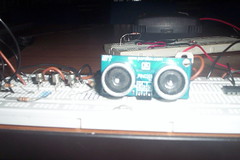The story of PING))) [Experiments with the ATNGW100 - Part 8]
The story of PING))) [Experiments with the ATNGW100 - Part 8]
2007-09-23T01:19:00
Well, this is a different kind of ping; and I have been playing with it for the past two days - the last technical issue to be resolved before I integrate everything and can start dreaming of this!
The Parallax PING sensor has a simple `one-wire' interface - you send a LOW-HIGH-LOW TTL pulse (HIGH around 10us) on its signal line (SIG) and it will wait for some time (about 750us) and then sends a burst of ultrasound. During this wait period, the sensor pulls SIG down to LOW - as soon as it transmits the ultrasound burst, SIG is made HIGH. SIG becomes LOW only when the echo is received. Thus, the width of the HIGH level on SIG gives you the round trip time. The problem here is that the AVR32 IO pins are not 5V tolerant (HIGH is 3.3V and absolute max voltage on an i/p pin is 3.9V). So what is essentially a zero-component connection between an I/O line and SIG becomes a bit more complicated ... Anyway, things are working fine now and I am able to get good measurements.
 Imagine how exciting it would be for beginning students if they get to play with a simple robot - studying both its hardware and software - instead of writing `find factorial of N' programs in the programming lab and `inventing' data to fit equations in the electronics lab! Imaginative teaching/learning is not something which only a Stanford or MIT can do - we too can do it. One of my `grand' objectives with this series of experiments is to finally produce enough freely available (GPL'd) course materials for something similar to MIT 6.01: Introduction to EECS 1 - but the trouble is, its going to consume a *lot* of my time. Will any University in India accept such a course? Assuming that I am going to spend a good amount of time on this, is there any chance of getting some funding?
Imagine how exciting it would be for beginning students if they get to play with a simple robot - studying both its hardware and software - instead of writing `find factorial of N' programs in the programming lab and `inventing' data to fit equations in the electronics lab! Imaginative teaching/learning is not something which only a Stanford or MIT can do - we too can do it. One of my `grand' objectives with this series of experiments is to finally produce enough freely available (GPL'd) course materials for something similar to MIT 6.01: Introduction to EECS 1 - but the trouble is, its going to consume a *lot* of my time. Will any University in India accept such a course? Assuming that I am going to spend a good amount of time on this, is there any chance of getting some funding?